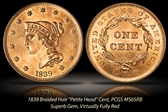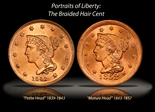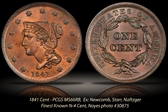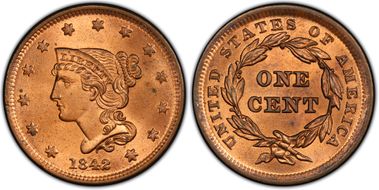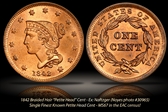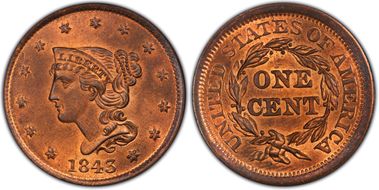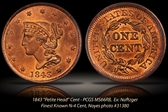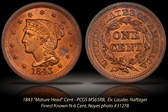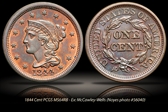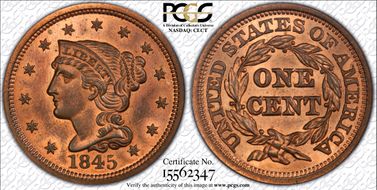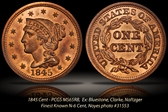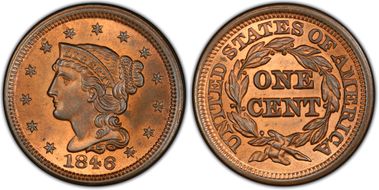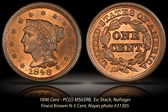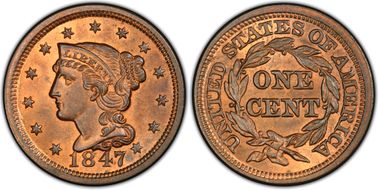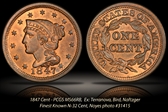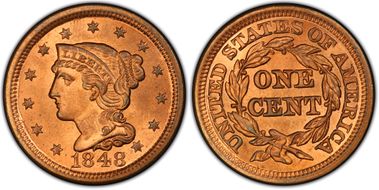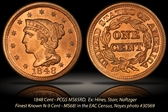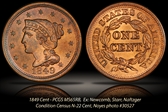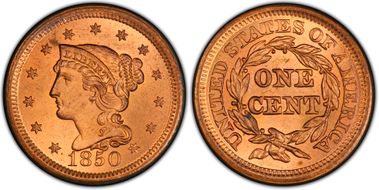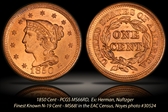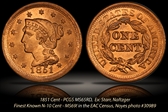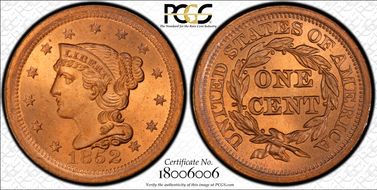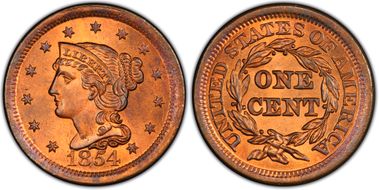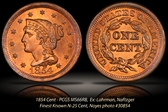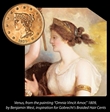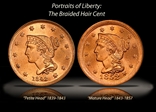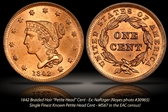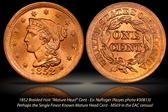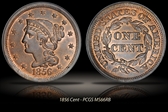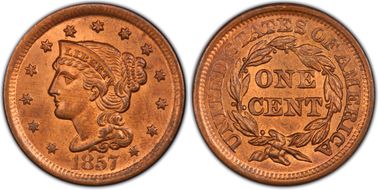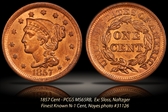Cardinal Collection 的钱币相册
Addressing the public criticism, Mint Engraver Christian Gobrecht began his re-design of the Coronet Cents in 1835, but his true inspiration came after an art exhibition in Philadelphia in 1839. There Gobrecht viewed the painting "Omnia Vincit Amor" ("Love Conquers All"), by artist Benjamin West. Struck by the beauty of West's portrayal of Venus, the Roman goddess of love, Gobrecht became inspired for another complete redesign of his own portrait of Liberty. The result was what we now call the "Braided Hair" design -- so-called for the braid of hair across Liberty's forehead beneath her coronet. Braided Hair cents continued in production from the latter part of 1839 through the final end of large cents in 1857. The design remained essentially unchanged throughout, with just a subtle modification made during 1843, when the portrait was enlarged slightly and re-oriented in its position on the die. The initial design has come to be called the "Petite Head," while the later design is referred to as the "Mature Head." The 1840 cent is from the N-8 variety, and it is not in the Noyes census. EAC64
Addressing the public criticism, Mint Engraver Christian Gobrecht began his re-design of the Coronet Cents in 1835, but his true inspiration came after an art exhibition in Philadelphia in 1839. There Gobrecht viewed the painting "Omnia Vincit Amor" ("Love Conquers All"), by artist Benjamin West. Struck by the beauty of West's portrayal of Venus, the Roman goddess of love, Gobrecht became inspired for another complete redesign of his own portrait of Liberty. The result was what we now call the "Braided Hair" design -- so-called for the braid of hair across Liberty's forehead beneath her coronet. Braided Hair cents continued in production from the latter part of 1839 through the final end of large cents in 1857. The design remained essentially unchanged throughout, with just a subtle modification made during 1843, when the portrait was enlarged slightly and re-oriented in its position on the die. The initial design has come to be called the "Petite Head," while the later design is referred to as the "Mature Head." The 1840 cent is from the N-8 variety, and it is not in the Noyes census. EAC64
Addressing the public criticism, Mint Engraver Christian Gobrecht began his re-design of the Coronet Cents in 1835, but his true inspiration came after an art exhibition in Philadelphia in 1839. There Gobrecht viewed the painting "Omnia Vincit Amor" ("Love Conquers All"), by artist Benjamin West. Struck by the beauty of West's portrayal of Venus, the Roman goddess of love, Gobrecht became inspired for another complete redesign of his own portrait of Liberty. The result was what we now call the "Braided Hair" design -- so-called for the braid of hair across Liberty's forehead beneath her coronet. Braided Hair cents continued in production from the latter part of 1839 through the final end of large cents in 1857. The design remained essentially unchanged throughout, with just a subtle modification made during 1843, when the portrait was enlarged slightly and re-oriented in its position on the die. The initial design has come to be called the "Petite Head," while the later design is referred to as the "Mature Head." The 1840 cent is from the N-8 variety, and it is not in the Noyes census. EAC64
While "only" graded by PCGS as MS65RD, the collection's specimen of the 1842 "Petite Head" cent is THE single finest known Petite Head Cent. Previously from the incredible Naftzger Collection, this coin is listed as MS67 in Bill Noyes' official EAC condition census, and this monster is well deserving of that praise. Described by copper expert Stewart Blay as "THE most important coin" in the Naftzger sale of late date cents, this coin was hotly contested and realized a well-deserved record price. (N-2 Noyes #30965)
While "only" graded by PCGS as MS65RD, the collection's specimen of the 1842 "Petite Head" cent is THE single finest known Petite Head Cent. Previously from the incredible Naftzger Collection, this coin is listed as MS67 in Bill Noyes' official EAC condition census, and this monster is well deserving of that praise. Described by copper expert Stewart Blay as "THE most important coin" in the Naftzger sale of late date cents, this coin was hotly contested and realized a well-deserved record price. (N-2 Noyes #30965)
1843 became the final transitional year for the portraits of Liberty on U.S. large cents, with the image of Liberty remodeled from the "Petite Head" to the "Mature Head", represented here by the N-4 Cent (Noyes #31380) and the N-6 cent (Noyes #31278).
1843 became the final transitional year for the portraits of Liberty on U.S. large cents, with the image of Liberty remodeled from the "Petite Head" to the "Mature Head", represented here by the N-4 Cent (Noyes #31380) and the N-6 cent (Noyes #31278).
1843 became the final transitional year for the portraits of Liberty on U.S. large cents, with the image of Liberty remodeled from the "Petite Head" to the "Mature Head", represented here by the N-4 Cent (Noyes #31380) and the N-6 cent (Noyes #31278).
Addressing the public criticism, Mint Engraver Christian Gobrecht began his re-design of the Coronet Cents in 1835, but his true inspiration came after an art exhibition in Philadelphia in 1839. There Gobrecht viewed the painting "Omnia Vincit Amor" ("Love Conquers All"), by artist Benjamin West. Struck by the beauty of West's portrayal of Venus, the Roman goddess of love, Gobrecht became inspired for another complete redesign of his own portrait of Liberty. The result was what we now call the "Braided Hair" design -- so-called for the braid of hair across Liberty's forehead beneath her coronet.-------------------------**Braided Hair cents continued in production from the latter part of 1839 through the final end of large cents in 1857. The design remained essentially unchanged throughout, with just a subtle modification made during 1843, when the portrait was enlarged slightly and re-oriented in its position on the die. The initial design has come to be called the "Petite Head," while the later design is referred to as the "Mature Head." The collection contains examples of both, both in magnificent gem condition.--------------------------------------------------------------------------**While "only" graded by PCGS as MS65RD, the collection's specimen of the 1842 "Petite Head" cent is THE single finest known Petite Head Cent. Previously from the incredible Naftzger Collection, this coin is listed as MS67 in Bill Noyes' official EAC condition census, and this monster is well deserving of that praise. Described by copper expert Stewart Blay as "THE most important coin" in the Naftzger sale of late date cents, this coin was hotly contested and realized a well-deserved record price.----------------------------------------------------------------------**While the Collection includes a number of awe inspiring pop-top "Mature Head" cents, its 1852 cent is the real standout. Another amazing Naftzger coin, this one appeared as Lot #1134 -- perhaps the very finest of all Braided Hair cents for the entire series 1839 to 1857. Numerous experts have opined the coin as MS67RD, and veteran dealer Laura Sperber has even been quoted in the numismatic press as stating it is the single finest large cent remaining from the 1850's era! Perhaps even more astonishing, though, is the fact that Bill Noyes has this coin listed in his official EAC condition census as MS69!! High praise, but then this museum piece is fully deserving.
Addressing the public criticism, Mint Engraver Christian Gobrecht began his re-design of the Coronet Cents in 1835, but his true inspiration came after an art exhibition in Philadelphia in 1839. There Gobrecht viewed the painting "Omnia Vincit Amor" ("Love Conquers All"), by artist Benjamin West. Struck by the beauty of West's portrayal of Venus, the Roman goddess of love, Gobrecht became inspired for another complete redesign of his own portrait of Liberty. The result was what we now call the "Braided Hair" design -- so-called for the braid of hair across Liberty's forehead beneath her coronet.-------------------------**Braided Hair cents continued in production from the latter part of 1839 through the final end of large cents in 1857. The design remained essentially unchanged throughout, with just a subtle modification made during 1843, when the portrait was enlarged slightly and re-oriented in its position on the die. The initial design has come to be called the "Petite Head," while the later design is referred to as the "Mature Head." The collection contains examples of both, both in magnificent gem condition.--------------------------------------------------------------------------**While "only" graded by PCGS as MS65RD, the collection's specimen of the 1842 "Petite Head" cent is THE single finest known Petite Head Cent. Previously from the incredible Naftzger Collection, this coin is listed as MS67 in Bill Noyes' official EAC condition census, and this monster is well deserving of that praise. Described by copper expert Stewart Blay as "THE most important coin" in the Naftzger sale of late date cents, this coin was hotly contested and realized a well-deserved record price.----------------------------------------------------------------------**While the Collection includes a number of awe inspiring pop-top "Mature Head" cents, its 1852 cent is the real standout. Another amazing Naftzger coin, this one appeared as Lot #1134 -- perhaps the very finest of all Braided Hair cents for the entire series 1839 to 1857. Numerous experts have opined the coin as MS67RD, and veteran dealer Laura Sperber has even been quoted in the numismatic press as stating it is the single finest large cent remaining from the 1850's era! Perhaps even more astonishing, though, is the fact that Bill Noyes has this coin listed in his official EAC condition census as MS69!! High praise, but then this museum piece is fully deserving.
Addressing the public criticism, Mint Engraver Christian Gobrecht began his re-design of the Coronet Cents in 1835, but his true inspiration came after an art exhibition in Philadelphia in 1839. There Gobrecht viewed the painting "Omnia Vincit Amor" ("Love Conquers All"), by artist Benjamin West. Struck by the beauty of West's portrayal of Venus, the Roman goddess of love, Gobrecht became inspired for another complete redesign of his own portrait of Liberty. The result was what we now call the "Braided Hair" design -- so-called for the braid of hair across Liberty's forehead beneath her coronet.-------------------------**Braided Hair cents continued in production from the latter part of 1839 through the final end of large cents in 1857. The design remained essentially unchanged throughout, with just a subtle modification made during 1843, when the portrait was enlarged slightly and re-oriented in its position on the die. The initial design has come to be called the "Petite Head," while the later design is referred to as the "Mature Head." The collection contains examples of both, both in magnificent gem condition.--------------------------------------------------------------------------**While "only" graded by PCGS as MS65RD, the collection's specimen of the 1842 "Petite Head" cent is THE single finest known Petite Head Cent. Previously from the incredible Naftzger Collection, this coin is listed as MS67 in Bill Noyes' official EAC condition census, and this monster is well deserving of that praise. Described by copper expert Stewart Blay as "THE most important coin" in the Naftzger sale of late date cents, this coin was hotly contested and realized a well-deserved record price.----------------------------------------------------------------------**While the Collection includes a number of awe inspiring pop-top "Mature Head" cents, its 1852 cent is the real standout. Another amazing Naftzger coin, this one appeared as Lot #1134 -- perhaps the very finest of all Braided Hair cents for the entire series 1839 to 1857. Numerous experts have opined the coin as MS67RD, and veteran dealer Laura Sperber has even been quoted in the numismatic press as stating it is the single finest large cent remaining from the 1850's era! Perhaps even more astonishing, though, is the fact that Bill Noyes has this coin listed in his official EAC condition census as MS69!! High praise, but then this museum piece is fully deserving.
Addressing the public criticism, Mint Engraver Christian Gobrecht began his re-design of the Coronet Cents in 1835, but his true inspiration came after an art exhibition in Philadelphia in 1839. There Gobrecht viewed the painting "Omnia Vincit Amor" ("Love Conquers All"), by artist Benjamin West. Struck by the beauty of West's portrayal of Venus, the Roman goddess of love, Gobrecht became inspired for another complete redesign of his own portrait of Liberty. The result was what we now call the "Braided Hair" design -- so-called for the braid of hair across Liberty's forehead beneath her coronet.-------------------------**Braided Hair cents continued in production from the latter part of 1839 through the final end of large cents in 1857. The design remained essentially unchanged throughout, with just a subtle modification made during 1843, when the portrait was enlarged slightly and re-oriented in its position on the die. The initial design has come to be called the "Petite Head," while the later design is referred to as the "Mature Head." The collection contains examples of both, both in magnificent gem condition.--------------------------------------------------------------------------**While "only" graded by PCGS as MS65RD, the collection's specimen of the 1842 "Petite Head" cent is THE single finest known Petite Head Cent. Previously from the incredible Naftzger Collection, this coin is listed as MS67 in Bill Noyes' official EAC condition census, and this monster is well deserving of that praise. Described by copper expert Stewart Blay as "THE most important coin" in the Naftzger sale of late date cents, this coin was hotly contested and realized a well-deserved record price.----------------------------------------------------------------------**While the Collection includes a number of awe inspiring pop-top "Mature Head" cents, its 1852 cent is the real standout. Another amazing Naftzger coin, this one appeared as Lot #1134 -- perhaps the very finest of all Braided Hair cents for the entire series 1839 to 1857. Numerous experts have opined the coin as MS67RD, and veteran dealer Laura Sperber has even been quoted in the numismatic press as stating it is the single finest large cent remaining from the 1850's era! Perhaps even more astonishing, though, is the fact that Bill Noyes has this coin listed in his official EAC condition census as MS69!! High praise, but then this museum piece is fully deserving.




















